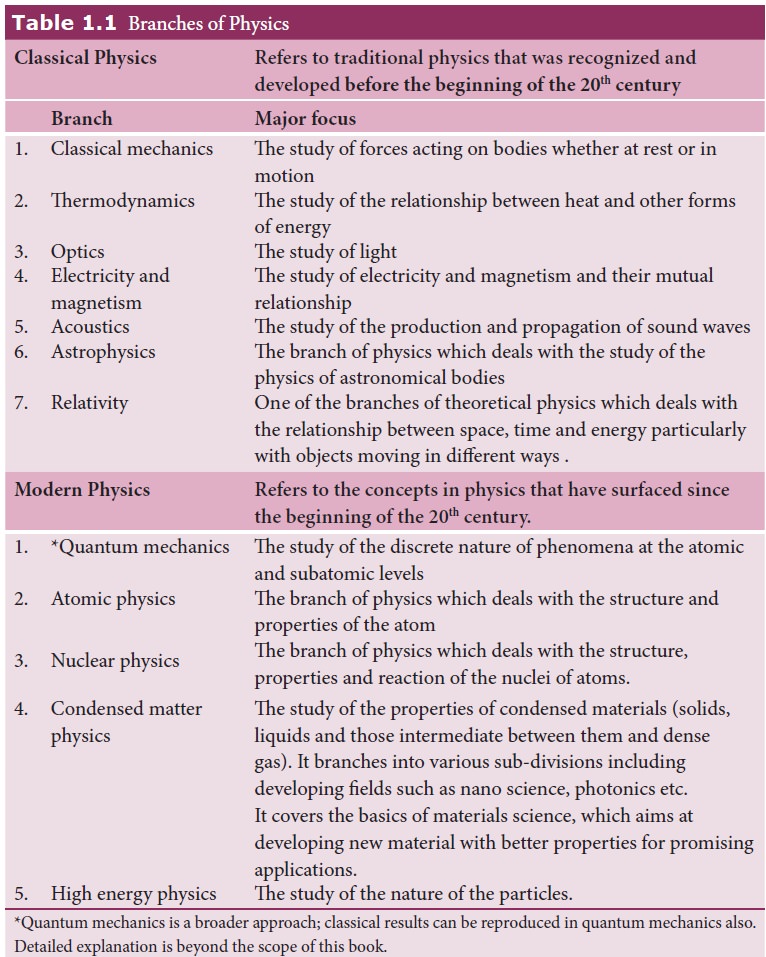Chapter: 11th Physics : UNIT 1 : Nature of Physical World and Measurement
Physics: Introduction
PHYSICS -
INTRODUCTION
The
word ‘physics’ is derived from the Greek word “Fusis”, meaning nature.
The study of nature and natural phenomena is dealt within physics. Hence
physics is considered as the most basic of all sciences.
Unification
and Reductionism are the
two approaches in studying physics. Attempting to explain diverse physical
phenomena with a few concepts and laws is unification. For example, Newton’s
universal law of gravitation (in unit 6) explains the motion of freely falling
bodies towards the Earth, motion of planets around the Sun, motion of the Moon
around the Earth, thus unifying the fundamental forces of nature.
An
attempt to explain a macroscopic system in terms of its microscopic
constituents is reductionism. For example, thermodynamics (unit 8) was
developed to explain macroscopic properties like temperature, entropy, etc., of
bulk systems. The above properties have been interpreted in terms of the
molecular constituents (microscopic) of the bulk system by kinetic theory (unit
9) and statistical mechanics.
Branches of Physics
Physics
as a fundamental science helps to uncover the laws of nature. The language of
its expression is mathematics. In ancient times, humans lived with nature -
their lifestyles were integrated with nature. They could understand the signals
from the movement of the Stars and other celestial bodies. They could determine
the time to sow and reap by watching the sky. Thus, astronomy and mathematics
were the first disciplines to be developed. The chronological development of
various branches of physics is presented in Appendix A1.1. The various branches
of physics are schematically shown in figure 1.1. The essential focus of
different areas is given in Table 1.1.

Some
of the fundamental concepts of basic areas of physics are discussed in higher
secondary first year physics books volume 1 and 2. Mechanics is covered in unit
1 to 6. Unit 1 gives an idea of the development of physics along with
discussion on basic elements such as measurement, units etc. Unit 2 gives the
basic mathematics needed to express the impact of physical principles and their
governing laws. The impact of forces acting on objects in terms of the
fundamental laws of motion of Newton are very systematically covered in unit 3.
Work and energy which are the basic parameters of investigation of the
mechanical world are presented in unit 4. Unit 5 deals with the mechanics of
rigid bodies (in contrast, objects are viewed as point objects in units
The basics of gravitation and its consequences are discussed in unit 6.
Older branches of physics such as different properties of matter are discussed
in unit 7.

The
impact of heat and investigations of its consequences are covered in units 8
and 9. Important features of oscillations and wave motion are covered in units
10 and 11.
Scope
and Excitement of Physics
Discoveries
in physics are of two types; accidental discoveries and well-analysed research
outcome in the laboratory based on intuitive thinking and prediction. For
example, magnetism was accidentally observed but the reason for this strange
behavior of magnets was later analysed theoretically. This analysis revealed
the underlying phenomena of magnetism. With this knowledge, artificial magnets
were prepared in the laboratories. Theoretical predictions are the most
important contribution of physics to the developments in technology and medicine.
For example, the famous equation of Albert Einstein, E=mc2 was a theoretical prediction in 1905 and
experimentally proved in 1932 by Cockcroft and Walton. Theoretical predictions
aided with recent simulation and computation procedures are widely used to
identify the most suited materials for robust applications. The pharmaceutical
industry uses this technique very effectively to design new drugs. Bio
compatible materials for organ replacement are predicted using quantum
prescriptions of physics before fabrication. Thus, experiments and theory work
hand in hand complimenting one another.
Physics
has a huge scope as it covers a tremendous range of magnitude of various
physical quantities (length, mass, time, energy etc). It deals with systems of
very large magnitude as in astronomical phenomena as well as those with very
small magnitude involving electrons and protons.
·
Range
of time scales: astronomical scales to microscopic scales, 1018s to
10−22s.
·
Range
of masses: from heavenly bodies to electron, 1055 kg (mass of known
observable universe) to 10−31 kg (mass of an electron) [the actual
mass of an electron is 9.11×10-31 Kg].
The
study of physics is not only educative but also exciting in many ways.
·
A
small number of basic concepts and laws can explain diverse physical phenomena.
·
The
most interesting part is the designing of useful devices based on the physical
laws.
For example i) use of robotics journey to Moon and to nearby planets with controls from the ground iii) technological advances in health sciences etc.
·
Carrying
out new challenging experiments to unfold the secrets of nature and in
verifying or falsifying the existing theories.
·
Probing
and understanding the science behind natural phenomena like the eclipse, and
why one feels the heat when there is a fire? (or) What causes the wind, etc.
In today’s
world of technological advancement, the building block
of all engineering and technical education is physics which is explained with the
help of mathematical tools.
Related Topics